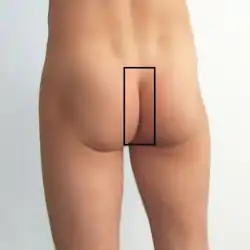Intergluteal cleft
The intergluteal cleft, also known by a number of synonyms, including natal cleft, anus slice, butt crack, and cluneal cleft, is the groove between the buttocks that runs from just below the sacrum to the perineum,[1] so named because it forms the visible border between the external rounded protrusions of the gluteus maximus muscles. Other names are the anal cleft, crena analis, arena interglutealis, “cleftal horizon”, and rima ani. Colloquially the intergluteal cleft is known as bum crack (UK) or butt crack (US). The intergluteal cleft is located superior to the anus.
| Intergluteal cleft | |
|---|---|
 Intergluteal cleft | |
| Identifiers | |
| TA98 | A01.2.08.003 |
| TA2 | 314 |
| FMA | 20234 |
| Anatomical terminology | |
Clinical significance
There are several disorders that can affect the intergluteal cleft including inverse psoriasis,[2][3] caudal regression syndrome,[4] and pilonidal disease.
References
- "Intergluteal cleft". Retrieved 15 July 2019.
- James, William (2005). Andrews' Diseases of the Skin:Clinical Dermatology. Saunders. pp. 193. ISBN 0-7216-2921-0.
- Tosti, Antonella; Piraccini, Bianca M (2005-01-01), Scher, Richard K; Tosti, Antonella; Elewski, Boni E; Daniel, C Ralph (eds.), "Chapter 11 - Dermatological Diseases", Nails (Third Edition), Edinburgh: W.B. Saunders, pp. 105–121, doi:10.1016/b978-141602356-2.50017-7, ISBN 978-1-4160-2356-2, retrieved 2020-11-03
- "Surgical Correction of Spinopelvic Instability in Children With Caudal Regression Syndrome". doi:10.1177/2192568218779984. PMC 6542167. Cite journal requires
|journal=(help)
This article is issued from Wikipedia. The text is licensed under Creative Commons - Attribution - Sharealike. Additional terms may apply for the media files.